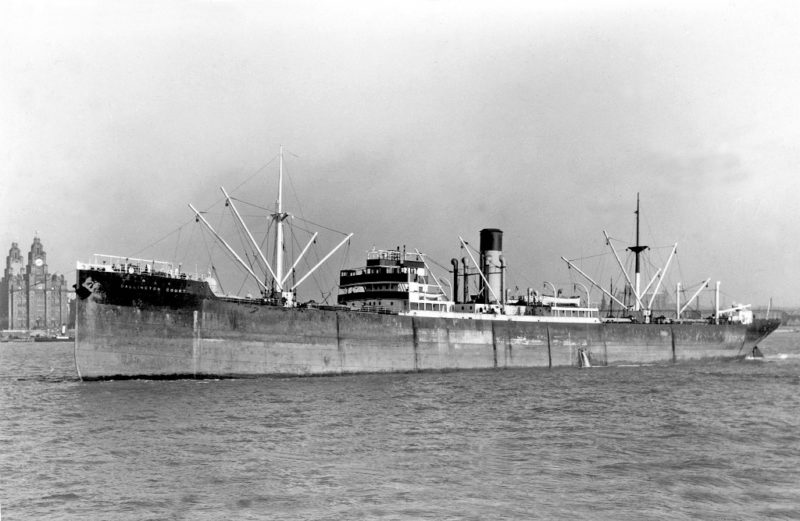
This proud fleet of tramps with their yellow funnels with black tops was started in 1905 by Philip Edward Haldinstein at the age of 25 years, trading at 1, Leadenhall Street, London as Haldinstein & Co. Ltd. His family hailed from Norwich but had a German-sounding name. His first tramp was completed on the Tyne in November of that year by R. Stephenson & Co. Ltd. as Arlington Court and sailed on her maiden voyage under Capt. S.H. Jones. A feature of the nomenclature was the alphabetical choice of English country houses ending in ‘Court’ and including ‘Ing’ in the middle, which although interrupted by WWI was carried down to Wellington Court of 1930. This naming system was restarted again when the fleet was rebuilt after the destruction of WWII.
Freight rates improved after 1908 allowing more new tramps to be ordered, and the letter ‘I’ had been reached by 1913 with Ilvington Court purchased as Dalebank from Dalecrest S.S. Co. Ltd. of London, managed by Harold Taylor and A. Worthington. Arlington Court traded world-wide under Capt. Robert Rooks throughout 1914 when taken on six months time-charter by the German Gans Line to carry cotton from New Orleans and Mobile to Europe. She then loaded coal in the Tyne for Marseilles in early July, and was requisitioned at Cardiff on her return.
Arlington Court was ordered to proceed to Abrolhos Rocks off the coast of Brazil to rendezvous with the South Atlantic fleet under Admiral Craddock. She arrived there on 27th October, but the fleet was far away engaging a German squadron at Coronel off Chile. She waited until 6th November when orders were received to proceed to an anchorage 3 miles outside the English Bank lighthouse in the Plate. Here the loss of the British warships was learnt, and the Hain line tramp Tregurno advised them to move back to Abrolhos to bunker the auxiliary cruiser Orama. The ships were made fast to each other while bunkering was taking place, but the rough sea made them roll heavily with frequent small collisions under water. No leaks were found on the tramp and she set sail for the Falklands to bunker the battlecruiser Invincible, a member of the victorious British squadron at the Battle of the Falk lands.
Arlington Court then came off charter and voyaged to Karachi to load wheat. She was given a 12-pounder as defence against submarines but due to the shortage of these guns it was taken off at Gibraltar and a 3-pounder substituted. Her speed was down to 5.75 knots due to marine growth and when a periscope was sighted travelling along the port side of the tramp only 200 yards away the worst was feared as the 3-pounder could not be depressed sufficiently to take aim. Amazingly no attack was made and Liverpool was safely reached early in 1916. Later that year on 30th October she was chased by a U-boat 50 miles SW of Cape St. Vincent but used her gun to good effect to escape. However she was torpedoed on 14th May 1917 off SW Ireland but was towed in and repaired. She was shortly afterwards sold to the Mitchell Steamship Co. Ltd., London with W.J. Williams as manager and renamed Penylan, a suburb of Cardiff.
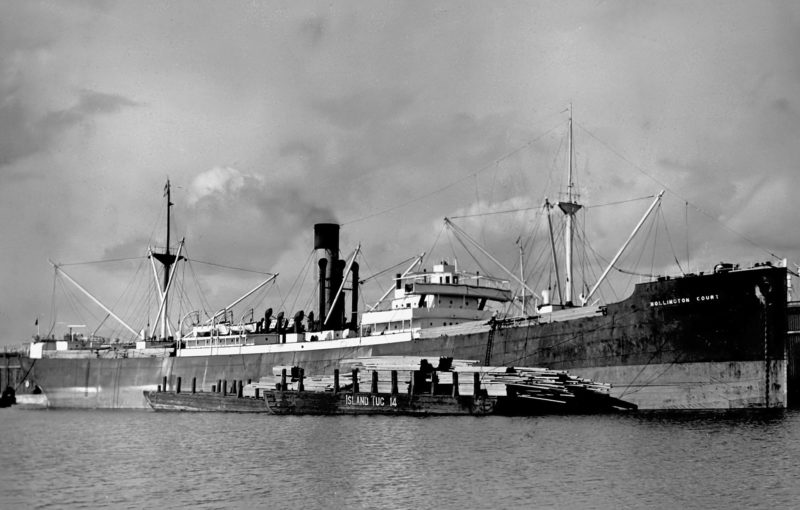
Dorington Court of 1908 had been sold in 1913 to P. Gjerding of Bergen and renamed Vally before passing to more famous fellow Norwegians as Romsdalsfjord of Norwegian America Line. She was replaced by a namesake for Court Line Ltd. by a tramp from Richardson, Duck & Co. Ltd. of Stockton in 1915. A backlash against all German sounding names in Britain on the outbreak of war persuaded Philip to shorten his name to the more English-sounding Haldin by Royal Licence on 15th June 1915. His fleet of nine tramps were fortunate in only losing one of their number, the Ilvington Court. She had loaded flour and ammunition at St. John (NB) for Northern France in March 1916. There was no convoy system at this time but she was to be given an escort from 200 miles SW of Ireland. However she mercifully stopped to rescue some 131 survivors from two torpedoed ships, the first of which made her late at the escort picking-up point. This delay probably saved her from destruction as the second ship was torpedoed at the pick-up location. However she was later destroyed when torpedoed and sunk 8 miles WNW of Cape Shershel, 60 miles west of Algiers, while on a voyage from the U.K. to Malta with coal, armour plating and Government stores on 6th December that year and 8 crew were lost.
Barrington Court had been taken over during the war by The Shipping Controller with Williams & Mordey as manager as Margam Abbey and was then torpedoed and badly damaged and beached in the Mediterranean on 1st November 1917. Errington Court was also mined in the Mediterranean on 7th June 1917 and beached. Refloated and repaired at Toulon she sailed for Cuba to load sugar and was homeward bound to the U.K. when the war finished. She was then sold in 1919 to the Leeston Shipping Co. Ltd. of London and renamed Bournemouth. Cressington Court was sold in 1918 to the Sutherland S.S. Co. Ltd. of Newcastle with B.J. Sutherland as manager and renamed Roxburgh, and in 1922 passed to Ridley, Son & Tully.
The fleet was only four tramps strong as the 1920s decade opened with Framlington Court of 1911, Geddington Court and Hannington Court of 1912, and Dorington Court of 1915. Due to the depressed freight rates Framlington Court was sold two years later to Greeks and renamed Cleanthis, but replaced with a new namesake costing £72,000 from Napier & Miller Ltd. of Glasgow in 1924 when freight rates were rising. Two new tramps also joined that year from the yard of Workman, Clark & Co. Ltd. at Belfast, the second
Arlington Court and Barrington Court, with two more from the same yard in 1925, Errington Court and Jevington Court. A Greek-owned tramp built at Hong Kong was purchased in 1924 and renamed Ilvington Court. A War ‘8’ standard tramp was purchased in February 1925 from Anchor-Donaldson Ltd. of Glasgow as Cabotia and renamed Cedrington Court.
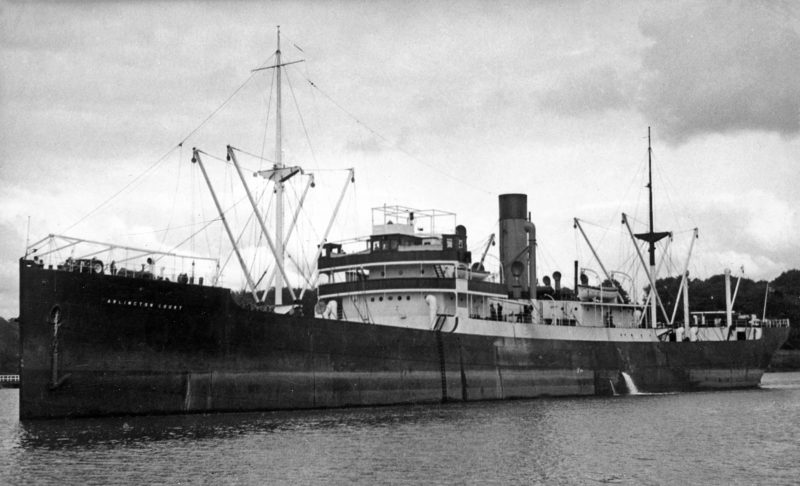
The fleet now entered a period of great expansion. The new Kensington Court was delivered by Napier & Miller Ltd. at Glasgow in 1927 and five other large tramps were purchased that year.
Three came from the fleet of Charles Radcliffe of Cardiff, whose tramps had been sold following his death in July 1926. He was the younger brother of Henry Radcliffe who founded the famous Cardiff tramp company of Evan Thomas, Radcliffe. His Conistone, Amblestone and Rochdale became Nollington Court, Ovington Court and Pennington Court. Two tramps built in 1920 at Tyne and Wear yards returned to the Red Duster from the Palermo company of Florio Socieda ltaliana di Nav and became Lavington Court and Mersington Court. Eleven new tramps of 9,000-10,000 dwt entered the Court Line fleet between Autumn 1928 and Spring 1930:-
Northumberland SB, Tyne – (4) Cressington Court, Dallington Court, Geddington Court, Quarrington Court
W.Pickersgill, Sunderland – (3) Uffington Court, Wellington Court, Aldington Court
Armstrong, Whitworth, Tyne – (2) Sinnington Court, Tilsington Court
Fairfield SB, Glasgow – (1) Rossington Court
R.Duncan, Glasgow – (1) Bonnington Court
Three of these eleven were motortramps, Aldington Court, Bonnington Court and Cressington Court, with Bonnington Court having a Kincaid type oil engine and the other two Doxford oil engines. Aldington Court sailed from London on her maiden voyage on 26th May 1930 for Vladivostock under charter to Glen Line with Glen funnel colours and houseflag. She was the first motorship for the company and the builder, and the 1850 bhp 3-cylinder engine performed well at her service speed of 10 knots. The whole fleet of 26 tramps was registered in 1929 under the United British Steamship Co. Ltd. except for the new Dallington Court which was under an old company, Framlington Syndicate Ltd., used only once before for Framlington Court of 1911. An important change in the management company occurred at the end of 1929 when Laurence Richard Philipps joined with Philip Haldin to form Haldin & Philipps Ltd., who were to remain the managers until 1948 when Sir Laurence (then Lord Milford) retired and the company reverted to Haldin & Co. Ltd. under Sir Philip Haldin. Laurence Philipps also owned a marine insurance company that bore his name, and was the sixth son of Sir James E. Philipps and youngest brother of Lord Kylsant of the Royal Mail Line and associated companies, who had a catastrophic business failure in 1930/31 shortly after Laurence joined the board of Court Line Ltd.
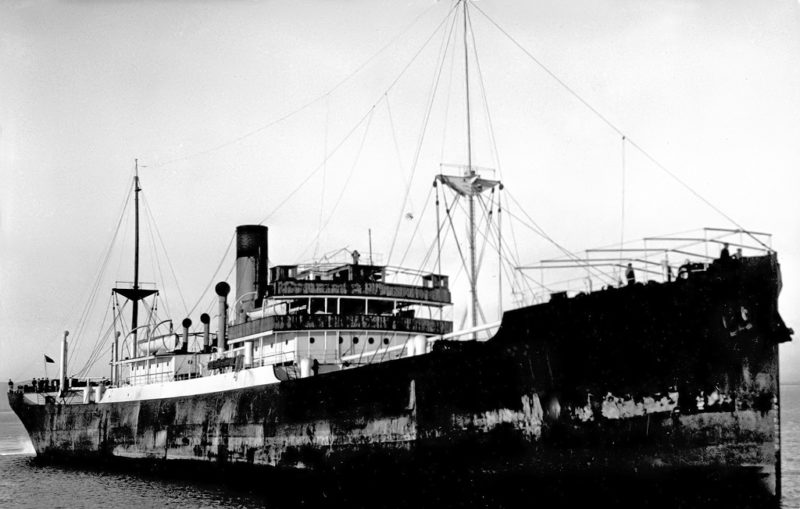
At the start of the depression in 1930 the Court Line fleet consisted of 26 mostly new tramps. It had reached this size just at the wrong time when no one wanted large tramps to carry world trade. In consequence, the majority of the fleet, some 20 tramps, were to remain permanently laid-up for years, with eight on the Tyne – Arlington, Barrington, Dorington, Ilvington, Jevington, Kensington, Mersington and Tilsington Courts. Five were round at Sunderland – Dallington, Nollington, Ovington, Sinnington and Wellington Courts, and six at Milford Haven – Cedrington, Errington, Framlington, Hannington, Lavington and Pennington Court.
It was almost possible to walk across the Tyne on the decks of Court Line tramps, and when one considers that these big tramps had a crew of at least 40 each, this represented a waste of nearly 1,000 lives. Many left the sea for good at this time and found alternative work far from home, including the author’s uncle who had spent a five year apprenticeship with the company. Bonnington Court stayed in employment when a two-year charter carrying lumber for Canadian Transport of Vancouver was obtained. The same company provided a further two-year charter for Hannington Court in 1934 and then further charters later in the 1930s, with the new motortramp Darlington Court of 1936 taking some of these. A further important trade at this time was coal out to Australia during the coal strike out there. Two variations were possible, either coal out to Melbourne and then after unloading going down Hobson’s Bay at Melbourne to commence loading grain and then back up the Bay to top off at Williamstown, or lumber from Vancouver which would be discharged at Sydney or Melbourne and then up to Mackay or Cairns in North Queensland to load sugar for either Japan or India. Cressington Court, Quarring-ton Court, Arlington Court and Bonnington Court all participated in these Australian trades particularly from Vancouver.
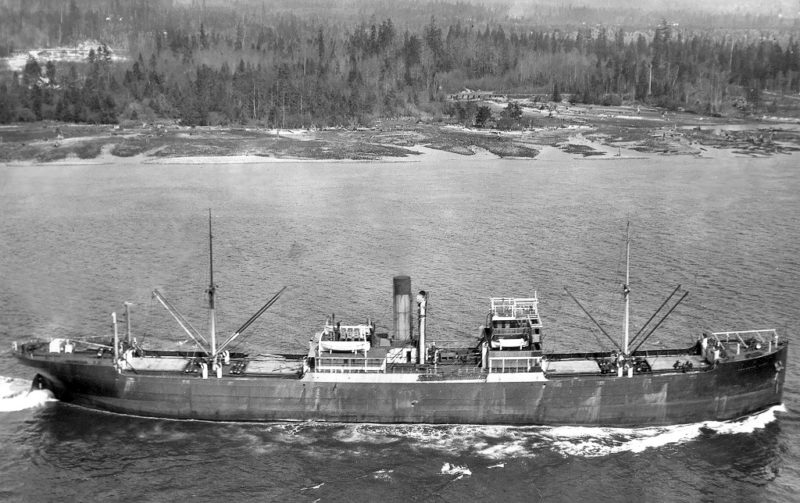
Although only four or five company tramps were trading at any one time losses were kept to a minimum, with a trading loss of £2,001 recorded in 1934 with no dividend paid. At the end of the depression the fleet was the third largest British tramp fleet, third only to Ropners of West Hartlepool and Reardon Smith of Cardiff. The fleet had a book value of £1.691 million and was kept intact with only one departure at this time with the old Hannington Court of 1912 being sold to A. Lauro of Italy and renamed Elios. She was taken as a prize on the Tyne in June 1940 and renamed Empire Brigade but was torpedoed and lost on 18th October that year West of the Hebrides.
Darlington Court of 1936 was a motortramp fitted with a Kincaid oil engine and completed by Lithgows at Port Glasgow. The fleet reverted to the ownership of Court Line Ltd. in 1936 from the United British S.S. Co. Ltd. Philip Haldin served on the Tramp Shipping Subsidy Committee between 1935/37, was knighted in 1939, and gave valuable service throughout the war to the Ministry of War Transport. The next new tramp was to play an unprecedented part towards victory in the coming war.
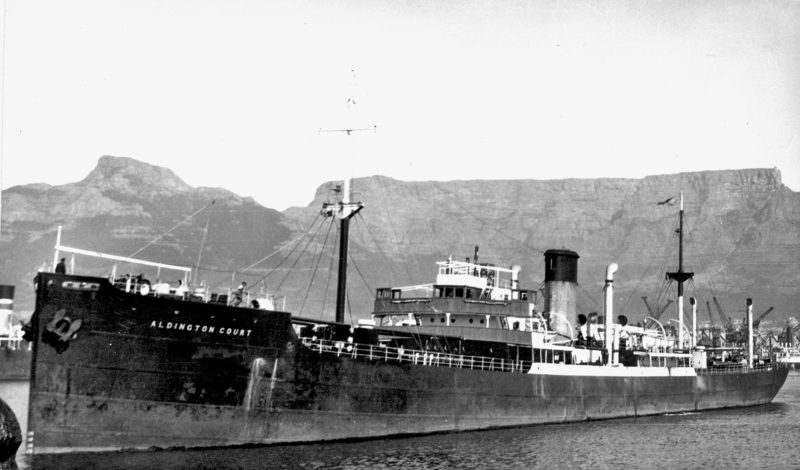
Dorington Court of 1938 was a steam tramp completed by J.L. Thompson & Sons Ltd. at Sunderland of 10,500 tons deadweight. She had five holds with the superstructure split by no. 3 hold and two masts with a total complement of ten small derricks. Her triple expansion engine was manufactured by the North Eastern Marine Engineering Co. Ltd. taking steam from two Scotch boilers to give an indicated horsepower of 2500 and a service speed of 11 knots. The reason for her place in history is that her design was the one selected by the Admiralty for the large ‘Empire’ building programme, and for the subsequent variations in the ‘Ocean’ and ‘Liberty’ types.
The old Corington Court of 1915 was sold to German owners in 1937, Quarrington Court and Nollington Court became marine losses at this time in the Red Sea and Caribbean.
The Doxford Economy motor tramp Hannington Court was completed before the outbreak of war in September 1939 but after only two years service she caught fire in July 1941 when 94 miles from Cape Town and sank.
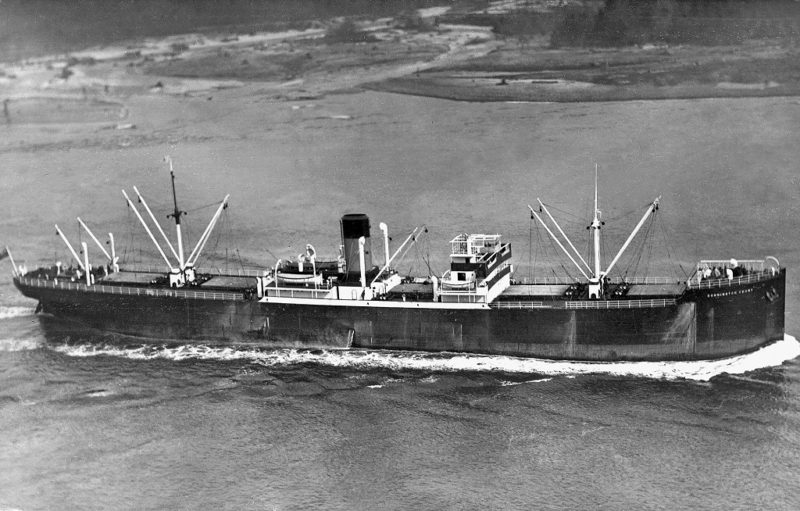
A fleet of 24 tramps was owned at the outbreak and 13 were to be lost due to enemy action:-

18.9.1939 Kensington Court Torpedoed/sunk 100 nm S of Cork o.v. Rosario/ Liverpool with grain
16.11.1939 Arlington Court Torpedoed/sunk 320 nm WSW of Start Point o.v. Rosario/Hull with maize
7.1.1940 Cedrington Court Mined/sunk 2 nm NE of North Goodwin L.V. o.v. Buenos Aires/Hull with wheat
24.2.1940 Jevington Court Mined/sunk 8.25 nm from Cromer Knoll L.V. o.v. Tyne to London with coal
15.4.1940 Mersington Court Captured/sunk at Narvik.
26.8.1940 Ilvington Court Torpedoed/sunk to E of Azores o.v. Pepel /Glasgow with iron ore
19.1.1941 Bonnington Court Bombed/sunk near Sunk L.V. o.v. Ipswich & Harwich to Tyne in ballast
20.5.1941 Darlington Court Torpedoed/sunk S of Cape Farewell o.v. New York & Halifax to Liverpool with wheat & aircraft, 28 lost
19.7.1942 Lavington Court Torpedoed near Azores o.v. Leith/Oban to Table Bay & Middle East with Government stores, 6 lost
19.8.1942 Cressington Court Torpedoed/sunk off Guiana o.v. Philadelphia & Trinidad to Durban & Alexandria with Government stores, 9 lost.
9.10.1942 Pennington Court Torpedoed/sunk in mid-Atlantic o.v. St. John (NB) & Halifax to Belfast with grain, all crew lost
31.10.1942 Aldington Court Torpedoed/sunk 900 nm NE of Tristan da Cunha o.v. Philadelphia & Trinidad to Saldanha Bay/Alexandria, 34 lost
24.11.1942 Dorington Court Torpedoed/sunk 400 m NE of Durban o.v. Calcutta & Madras to Lourenco Marques, Durban & U.K. with general cargo, 4 crew lost
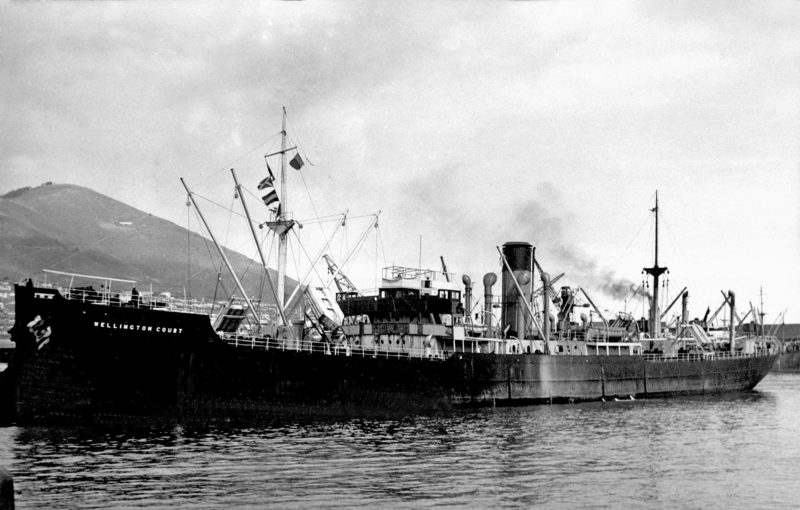
Arlington Court under Capt. Hurst took two torpedoes from U43 in the homeward convoy SL 7 from Freetown. The radio room and bridge were wrecked with three dead in the explosion and Capt. Hurst reluctantly gave the order to abandon ship as he had already survived three WW I torpedo attacks. The crew took to the lifeboats and 22 from one boat were rescued although the Chief Engineer died from exposure, and six survived in the second boat after wallowing for six bitterly cold days and nights with an 18-year old apprentice in charge to give encouragement and set the course.
Sinnington Court rescued most of the survivors of the Blue Funnel Pyrrhus, which was acting as Vice Commodore of convoy OG18 for Gibraltar when she was torpedoed and sunk on 17th February 1940. The convoy had only two small French warships as escort.
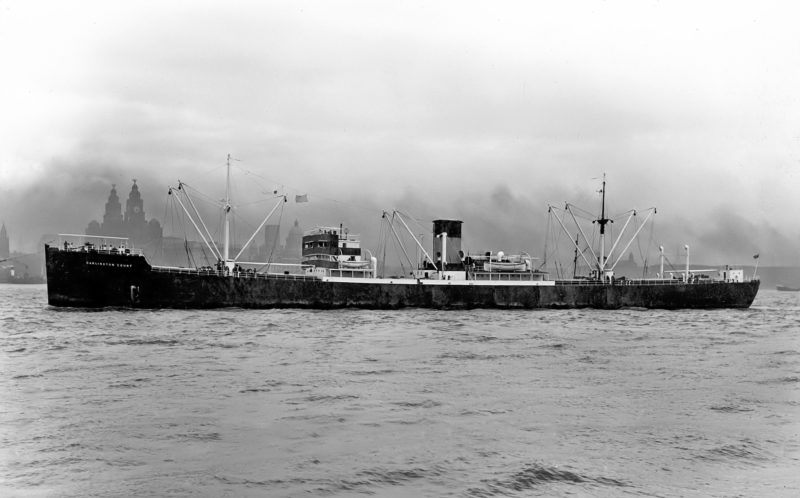
Darlington Court was torpedoed and sunk by U-556 in convoy HX126 in the dreaded area to the south of Cape Farewell. Twenty five crew were killed but Capt. Hurst survived this brush with death as he had done when in command of Arlington Court 18 months earlier. Lavington Court was completed in June 1940 by Harland & Wolff Ltd. at Govan as a motortramp, and two years later she set sail in convoy OS34 from the Leith and Oban for Freetown and the Middle East with Government stores. On 19th July 1942 when north of the Azores she was struck forward by a torpedo from U-564 which blew her bows off. Abandoned but remaining afloat for many days and tugs were despatched from the U.K. but she sank in tow on 1st August in the Western Approaches.
The company owned survivors of the destruction were Framlington Court of 1924, Barrington Court of 1924, Errington Court of 1927, Geddington Court of 1928, Sinnington Court of 1928, Tilsington Court of 1928, Uffington Court of 1929, Wellington Court of 1930 and Dallington Court of 1929.
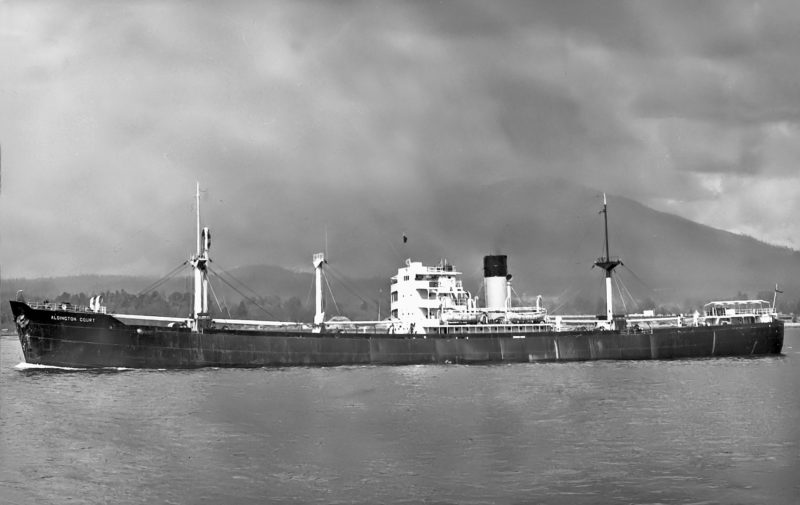
Framlington Court had received serious collision damage off the Tyne in July 1943,and although repaired was sold in 1945 and renamed Stancourt. Eight standard types had been managed for the M.O.W.T. during the war and now the need for new ships was urgent, and the standard 10,000 dwt Empire Lord sailed from Swansea in July 1945 on a 21 month voyage during which she was purchased by Court Line and became Aldington Court. Her full voyage was:-
12.7.1945 Swansea, Cornerbrook, Montreal (Manz Line charter), Panama, Auckland, Wellington, Lyttelton, Dunedin, Wellington, Auckland (grain), Colombo, Bombay, Port Louis (sugar), Durban to River Plate with coal returning with grain on repeated basis, River Plate (grain), Durban (bunkers), Madras, Colombo (dry-dock), Adelaide, Port Pirie (grain), Port Lincoln (grain), Calicut & Vizagapatnam (manganese ore), Calcutta (general), Colombo, Port Said, Azores (engine repairs), St. John, Baltimore, Newport News, Norfolk, Virginia, New York (Cunard charter), London, Tyne where she arrived on 3.4.1947 for dry-docking.
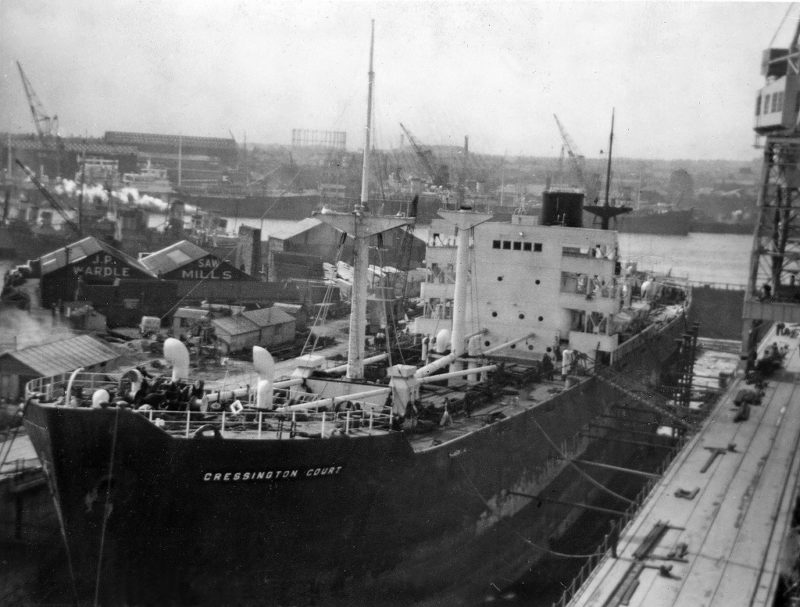
Two ‘Empire’ type sisters were purchased in 1946 and renamed Cressington Court and Dorington Court, plus the similar Epsom from the Britain S.S. Co. Ltd. in 1950 which was renamed Errington Court. Barrington Court of 1924 was sold in 1948 to the La Tunisienne S.N. Co. Ltd. of London with Frank C. Strick as manager and renamed Leon de Nervo. Errington Court of 1927 was sold to Greeks in 1947 and renamed Tharros and Geddington Court and Sinnington Court were sold to Japanese buyers in 1951 with sister Tilsington Court going to Italy. The sale of the last pre-war tramp Uffington Court in 1952 to Swedish buyers left the company with four war-time ‘Empire’ types.
A new-building programme got under way in 1952 with the completion of Barrington Court and Framlington Court from Wear shipyards. These were open shelter-deckers with very fine lines for tramps and together with their streamlined bridges and grey hulls had a very smart appearance. They had four main cargo holds with two of these and a deep tank forward of the machinery space, and two holds aft. Their B&W type oil engines were capable of running on heavy fuel oil to give a service speed of around 13 knots. Seven were completed with Dorington Court and Errington Court both launched in July 1957, the month that freight rates dropped severely and stayed that way until the mid-1960s. Two further options for delivery of seven motortramps of 12,000-13,000 dwt in 1962/63 were then cancelled.
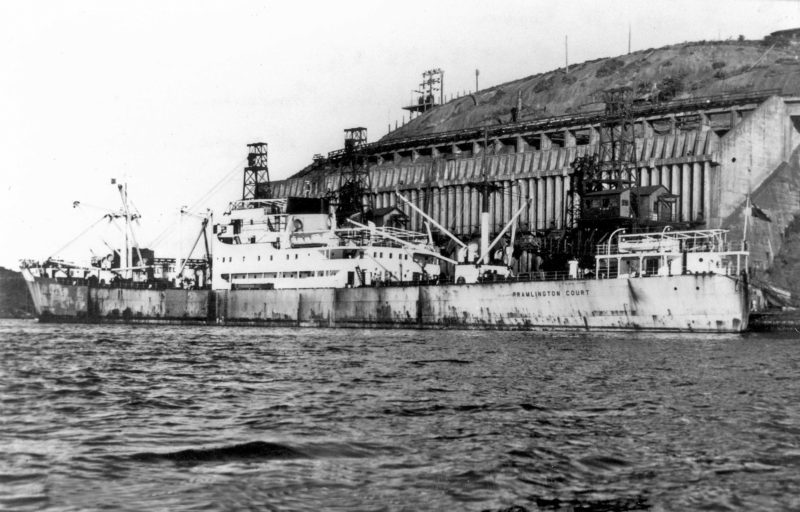
The four ‘Empire’ types were then all sold off by 1959. The economic advantages of shipping bulk cargoes in larger sizes began to be seen in the early 1960s, and the seven small tramps were soon at a disadvantage compared with the bulk carrier.
The company purchased the bulker Hector Halcyon in December 1961. She was of 25,324 dwt and had been completed six months earlier at Boelwerf yard at Tamise in Belgium and was renamed Cressington Court. Her economic superiority was quickly grasped by the company and the seven small motortramps had all been sold off by 1963. Arlington Court of 14,300 dwt was completed in 1962 by Bartram with engines ‘three-quarters aft’ but was sold in 1963.
Shipowning now became a smaller part of activities within Court Line Group, and together with a switch to tankers from the mid-1960s onwards presented a very different picture. Cressington Court was sold in June, 1966 to Christian Salvesen of Leith and renamed Inverleith. The first tanker was purchased in 1963 and renamed Halcyon Days and given entirely new markings. The funnel had a black top and blue bottom with a broad white band carrying a stylised ‘C’ shaped to represent the wings of the bird called a Halcyon (Kingfisher). This bird was fabled by the ancients to breed in a floating nest, and to charm wind and waves to a calm for its mating! However, shipowning companies have to get used to the cyclical boom and slump and stormy days were ahead. A 47,000 dwt Spanish-built tanker and a VLCC of 227,000 dwt were delivered in 1971, and three smaller tankers were purchased.
Extensive interests in airlines, shipbuilding, ship-repairing and the packaged holiday trade brought enormous cash-flow problems in 1974 and the Court Line Group went into liquidation. The Sunderland shipyards owned by the Group were taken over by the Government.
The Halcyon days were over for ever!
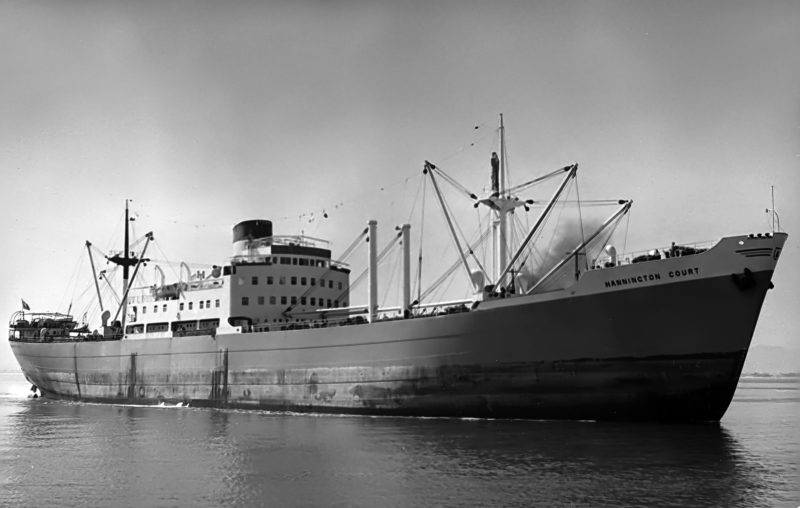

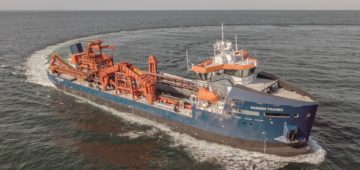



Comments
Sorry, comments are closed for this item